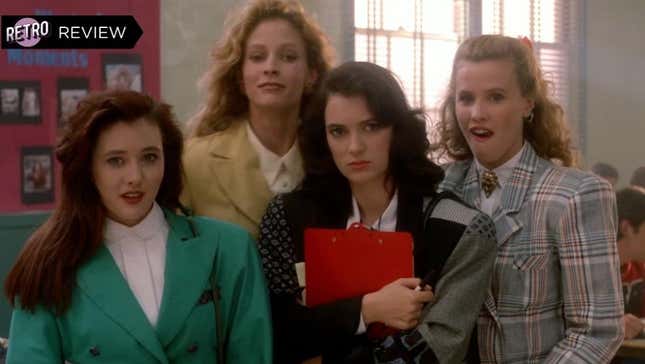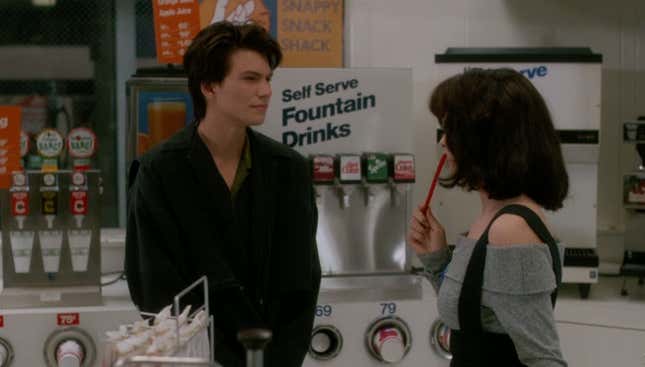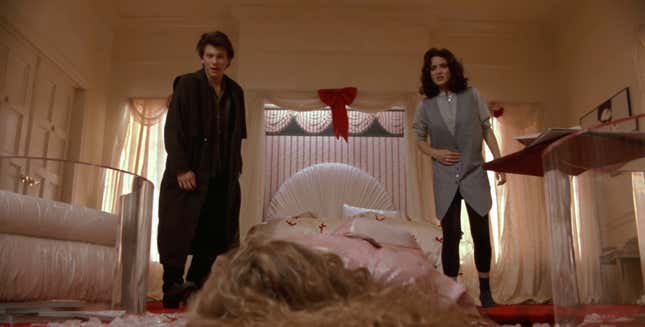
Heathers was released in theaters March 31, 1989, capping a decade of teen movies more defined by John Hughes comedies (The Breakfast Club, Ferris Bueller’s Day Off) than wickedly acidic satire. Other high school-centric films in 1989 included Say Anything, Dead Poets’ Society, and Bill & Ted’s Excellent Adventure—wildly different movies that all share a certain earnestness. Heathers, meanwhile, looked at its audience, rolled its eyes, and asked, “What is your damage?”
Though Heathers has lived on in a musical (which played Off-Broadway in 2014; and London’s West End in 2018) and a TV series (which ran one season in 2018 on the Paramount Network), it’s the original film—written by Daniel Waters and directed by Michael Lehman, both making their feature debuts—that still makes the most impact. It remains a scathing indictment of the cruel high-school caste system in an era before social media, and its incisive ideas are couched in an almost ridiculously quotable script (“Fuck me gently with a chainsaw!”) that’s just as entertaining as it was in 1989. That said, some elements haven’t aged as well as others; the cast is 95% white, and the homophobic jokes—which do serve a story purpose and come only from the mouths of blatant idiots and bullies—are a bit jarring to hear in 2024.

Beyond that, though, there’s a timelessness to Heathers that owes a lot to its tone, a unique blend of wry, weary despair—“teen angst bullshit” (to quote Winona Ryder’s character)—and sly intelligence, wrapped up in production design that puts a heightened vibrance on high-school style and settings. Few teen movies have ever made such careful use of color, famously coding each croquet-playing Heather character with a hue that not-so-subtly reflects her personality. There’s Heather Chandler (Kim Walter), the original Mean Girl, clad in devilish red; Heather McNamara (Lisanne Falk), whose yellow choices represent her cautious, “what’s everyone else doing?” approach to life; and Heather Duke (Shannen Doherty), whose green-with-envy outfits morph into red when she takes Heather Chandler’s place at the top of the pack.
Somehow also in this group is Veronica (Ryder, who’s just 16 and anchors the film with world-weary excellence)—a fan of blue, usually matched with black—whose presence among the Heathers is never fully explained, beyond Heather Chandler snapping a reminder that “You wanted to be a member of the most powerful clique in school.” We know that Veronica has less snobby friends in her recent past, and early in Heathers she forms a relationship that will wreak havoc on the carefully constructed boundaries at Westerburg High School: falling for bad-boy new kid J.D. (Christian Slater), who’s all too happy to help Veronica make good on her furious declaration—written in her diary, and read to the audience as voice-over narration—that “I must stop Heather.”

Heathers shifts from snarky high-school comedy to pitch-black commentary on society at large once J.D. and Veronica commit their first murder. They cover up their crime by staging Heather Chandler’s demise—which is entirely their fault, though whether Veronica actually intends to kill her frenemy is somewhat debatable—as a suicide, helped along by Veronica’s convenient ability to imitate anyone’s handwriting. As their body count rises, Veronica is horrified by the reaction in her suburban Ohio town. Her paté-loving parents, whose interest in her barely strays beyond who her prom date might be, are as out of touch as Westerburg’s teachers, who treat the “suicide cluster” in their midst as either an inconvenience or something to exploit for publicity. The local cops are similarly portrayed as out-of-touch fools, and J.D.’s wild-eyed father is too infatuated with his building-demolition business to offer any sort of sane guidance.
In this world, teens are left to their own devices—or to call in to a talk radio show, Hot Probs, which dispenses dubiously useful life advice—and it’s no surprise so many of them have sprouted into toxic human beings. “Chaos is what killed the dinosaurs, darling!” J.D. says gleefully to Veronica, all while plotting to set off a bomb during a pep rally that will be justified by a “suicide note” signed by the entire school. (Another one of his bon mots is “The extreme always seems to make an impression.”) It’s startling to watch Heather’s last act knowing that just 10 years later, Columbine would forever change our perception of how terrifying real-life school violence can be—in fact, it’s impossible not to think about it, even as Veronica manages to save her classmates from mass destruction.
At the end of the movie, Veronica informs Heather Duke “there’s a new sheriff in town,” and there’s hope that maybe Westerburg will become a kinder, more inclusive place now that the most popular and/or most homicidal students have been eliminated. But Heathers also leaves viewers with a final warning. Though its in-universe theme is pop ditty “Teenage Suicide (Don’t Do It),” Heathers begins and ends with different versions of the same song: “Que Sera, Sera (Whatever Will Be, Will Be)”—which cautions us that “the future’s not ours to see.” Things could get better, or they could revert to awful again, and that feels like an ending that’s both truthful to life and to Heathers’ own worldview. To quote Veronica: “Lick it up, baby. Lick. It. Up.”
Heathers is streaming on Prime Video.
Want more io9 news? Check out when to expect the latest Marvel, Star Wars, and Star Trek releases, what’s next for the DC Universe on film and TV, and everything you need to know about the future of Doctor Who.